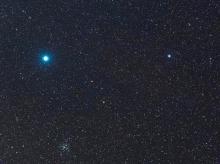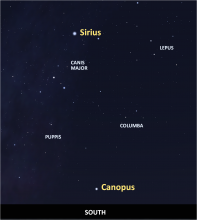Listen to today's episode of StarDate on the web the same day it airs in high-quality streaming audio without any extra ads or announcements. Choose a $8 one-month pass, or listen every day for a year for just $30.
You are here
Sirius Rising
The brightest star in all the night sky is clawing its way into prime-time viewing. Sirius is low in the southeast by 10 p.m., and high in the south after midnight. It’s the brightest star of the constellation Canis Major, the Big Dog, so it’s also known as the Dog Star.
Like all the stars that twinkle in the night, Sirius’s brightness is a combination of two factors: its true brightness and its distance.
In fact, Sirius really is a bright star — about 25 times brighter than the Sun. That’s because it’s about twice as massive as the Sun. It “burns” the nuclear fuel in its core in a hurry, so it produces lots of radiation. That energy pushes outward on the surrounding layers of gas, making Sirius bigger than the Sun. It also heats the gas to higher temperatures, so any given area on Sirius radiates more energy into space than the same-size area on the Sun. The combination of the size and surface temperature makes Sirius a real shiner.
The other reason Sirius shines so brightly in our sky is its distance — just 8.6 light-years away. That makes it the fifth-closest star system to the Sun. And it’s moving even closer, so it’ll remain the brightest star in the night sky for tens of thousands of years to come.
Keep an eye on Sirius tonight and throughout the winter — a close and shiny neighbor climbing high across the southern sky.
We’ll talk about an even brighter star in the Big Dog tomorrow.
Script by Damond Benningfield






